| Article ID | Journal | Published Year | Pages | File Type |
|---|---|---|---|---|
| 4677524 | Earth and Planetary Science Letters | 2012 | 10 Pages |
Lava flows can produce changes in topography of the order of 10s–100s of metres. A knowledge of the resulting volume change provides evidence about the dynamics of an eruption. Using differential InSAR phase delays, it is possible to estimate height differences between the current topography and a digital elevation model (DEM). This does not require a pre-event SAR image, so it does not rely on interferometric phase remaining coherent during eruption and emplacement. Synthetic tests predict that we can estimate lava thicknesses of as little as ∼9m, given a minimum of five interferograms with suitably large orbital baseline separations. In the case of continuous motion, such as lava flow subsidence, we invert interferometric phase simultaneously for topographic change and displacement. We apply this to Santiaguito volcano, Guatemala, and measure increases in lava thickness of up to 140 m between 2000 and 2009, largely associated with activity between 2000 and 2005. We find a mean extrusion rate of 0.43±0.06 m3/s, which lies within the error bounds of the longer term extrusion rate between 1922 and 2000. The thickest and youngest parts of the flow deposit were shown to be subsiding at an average rate of ∼−6cm/yr. This is the first time that flow thickness and subsidence have been measured simultaneously. We expect this approach to be suitable for measurement of landslides and other mass flow deposits as well as lava flows.
► We measure topographic change >9m at a volcano with InSAR. ► Approach suitable for measuring lava/pyroclastic flow compaction or landslides. ► Lava thickness and extrusion rate (2000–2009) measured at Santiaguito volcano. ► We make first simultaneous measurements of lava thickness and subsidence rate.
